| 1 | Blue body, red head |
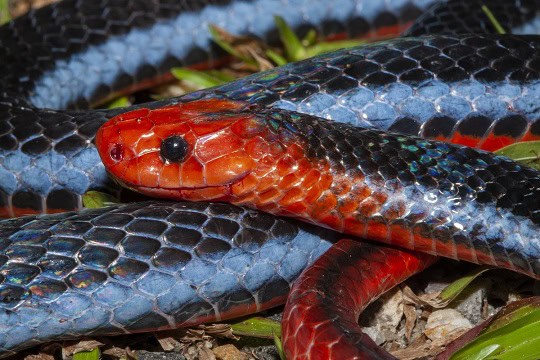
The Malaysian blue coral snake lives in 5 countries across south-east Asia, and is easily one of the most fantastical looking species in the world. It’s a moderate length snake at an average of 140cm, with the longest individual of all time reaching 185cm. Its nose is blunt in order to help it forage through leaves, and it has jet black eyes rather than the classic vertical pupils of vipers…
…but the most fantastical feature of this snake is easily its rich blue scales, with lighter electric blue lines running down its flanks. This is contrasted by a bright red-orange head, which begins suddenly and sharply, with no gradual tapering in. The tail is also deep red, and begins equally suddenly.
Why the blue coral snake evolved these colour patterns is a mystery. It lives in remote forest habitats rich with fallen leaves, at altitudes of 100-1000 metres. The colours offer no camouflaging ability, but it’s theorised that they act as a deterrent to predators, sending out “stay away” warning signals of extreme poison similar to an exotic frog. This is a severely venomous snake which no human being should ever pick up, and the Malaysian blue coral snake most likely wants to warn the whole world of that fact.
| 2 | Preys on fellow snakes |
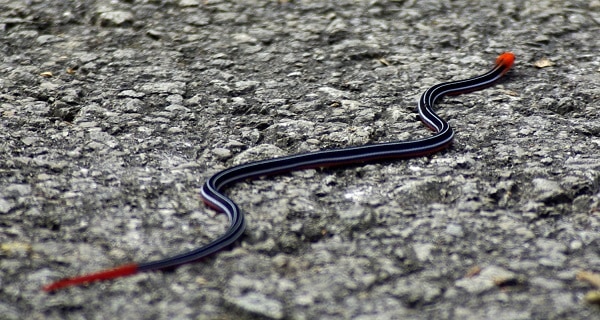
The red-necked keelback relies on frogs, while the golden tree snake eats mountains of Tokay geckos. The Malaysian blue coral snake has the rare diet of eating mostly other snakes. They’ve been dubbed the “killer of killers” and one of its favourites is the juveniles of the iconic king cobra species.
As an adult the king cobra inspires terror, with its iconic neck flaps that spring outwards as they prepare to strike. But the babies are defenceless, and they inhabit a large chunk of the Malaysian blue coral snake’s range, including Thailand and Malaysia.
Blue coral snakes also eat lizards and frogs if they can get their non-existent hands on them, and they’re mostly a nocturnal species, hunting under cloak of darkness. However, they sometimes emerge in early morning after heavy night rains which make their leaf litter dens wet. They’re even known to eat their own species, and their hunting relies purely on venom rather than constriction.
| 3 | Unbeatable for rapid paralysis |
Blue coral snakes don’t quite have the deadliest venom ever, but they’re more than capable of ending human life. The LD50 score is 0.81mg, comparing respectably to the record-holding inland taipan at 0.025mg. Most importantly, blue coral venom has a unique feature: instant full bodily paralysis.
Numerous snake venoms can cause gradual paralysis, preceded by trouble swallowing, trouble walking, and trouble speaking, but blue coral snake venom can freeze your muscles solid within seconds. This is because of their snake heavy diet, which carries a massive risk of being envenomated themselves. Other snakes can deliver a rapid bite and stand back while their rodent prey staggers around and slowly dies, but the blue coral snake needs to disable its prey instantly, particularly if it’s a venomous cobra.
This instant paralysis is found elsewhere in the animal kingdom, such as in the underwater cone snail, which needs to disable fast, nimble fish. But in snakes, it’s almost unheard of.
| 4 | The secret ingredient – calliotoxin |
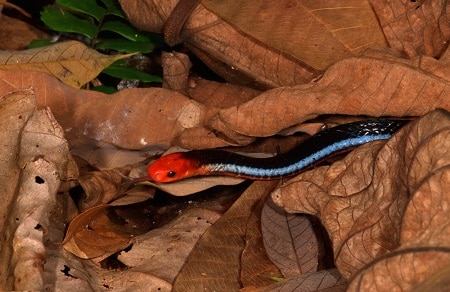
The venom of this futuristic snake is missing several classic snake toxins. For one, there are no post-synaptic neurotoxins, which sever the communication channels between brain and body and can trigger death via lung failure. This is a big difference to its coral snake cousins living in America.
Instead, the blue coral snake injects maticotoxin, a rare cytotoxin which attacks cells and causes their walls to catastrophically rupture. This makes up 30% of blue coral venom, making it the second most abundant toxin, and the first ranked is phospholipidase A2, a more common cytotoxin found in the majority of snakes. PLA2 is partially responsible for the horrific swelling of the bite zone.
Another unique toxin is vespryn, and then there’s the secret ingredient, the toxin behind the instant paralysis. This is called calliotoxin, and is found in no other snake species. Calliotoxin has no known antidote, which is a big difference to the nearby Malaysian blue krait, which is also severely deadly but cushioned by virtually every Thai hospital stocking the antivenin.
| 5 | Could be a future pain drug |
To paralyse its prey, calliotoxin acts on the body’s sodium channels. Normally, these channels fire on and off constantly, but blue coral snake venom delays the rate of their inactivation, causing all the body’s neurons to overfire at once. The communications between them are severely disrupted and the result is instant paralysis, accompanied by severe muscle spasms.
Strangely though, scientists are interested in this process for medical reasons. The same sodium channels are responsible for transmitting pain in humans, and such a powerful compound could be altered in a lab to relieve chronic pain conditions instead.
This wouldn’t be a first, as the blood pressure drug captopril was discovered through the venom of the Brazilian pit viper, which causes a fatal blood pressure drop. Captopril was approved by the FDA in 1981, and since then an antiplatelet medication called tirofabin has been created using the saw-scaled viper. In both cases, scientists took a toxin and altered its molecular structure slightly, turning it from evil to good. Calliotoxin is expected to follow the same path.
| 6 | Freakishly long venom glands |

Malaysian blue coral snakes have the longest venom glands of any known species, stretching one third of the way down their 1.5 metre body. The longest blue coral snakes have venom glands measuring 60cm.
The glands are thin and orange in colour, and the core of the gland is located in the centre of the snake’s body within its ribcage. The rest consists of a thin duct stretching all the way down to the fangs, attached to them intricately so that the mildest bite releases a fountain of venom like an overloaded ink pen.
For unknown reasons, the left venom gland is always larger than the right. These massive glands result in a high venom injection as well. One study recorded a yield of 65.63-71.40mg per bite, which is significantly less than the common death adder of Australia at 70mg to 236mg. But another found that a 1.2 metre snake injected 150mg per bite, easily enough to kill a human being.
| 7 | Capable of killing humans |
The blue coral snake rarely bites human beings, but at least two deaths are known. The first was a 5 year old Malaysian boy who was bitten on the base of his thumb in 1956, and died 2 hours later. The second was a Singapore man who died within 5 minutes after being bitten twice on the toes in 1985. This study stated that “while there are very few human C. bivirgatus envenomations on record, the majority were lethal“.
In southeast Asia, this snake is nicknamed the “100 paces snake” because the victim is highly unlikely to walk that far before collapsing to the floor dead.
Toes and thumbs are the locations you’d expect, as the blue coral snake is a non-aggressive species which rarely attacks humans. If they see a human, they usually stay still and barely react. Like the Russell’s viper, the main bite scenarios are on the toes if you accidentally step on one, or on the fingers if you’re rummaging through the undergrowth foraging for plants.
| 8 | Habitat: dependent on forests |
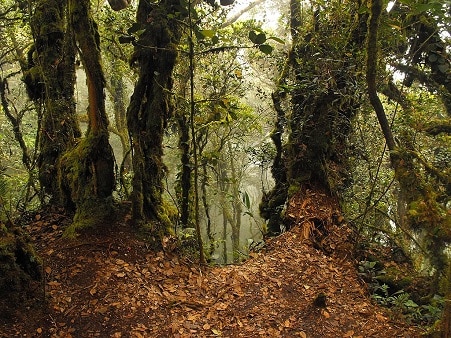
The blue coral snake is a rainforest species, meaning that humans rarely encounter them. This is the exact opposite of the Russell’s viper, which eats rodents as its staple and is constantly attracted to busy rural farms, giving it a bite count of thousands per year. Malaysian blue snakes are usually seen slithering down remote forest paths, and their favourite resting spots are thick piles of leaf litter.
Unfortunately, this snake may be in trouble. Its dependence on forest habitats may be its undoing, as many are being chopped down and converted into palm plantations. The species isn’t officially endangered on the ICUN list, but 80% of its habitat may have disappeared over the last two decades. Dr Byran Fry was the scientist who led the paralysing venom study, and he claimed while searching for specimens in the wild, he only spotted two blue coral snakes in total. “They’re really rare” he told the BBC in 2016.
This rarity means that their venom is very expensive, at over $4000 per gram.
| 9 | The blue coral snake empire |
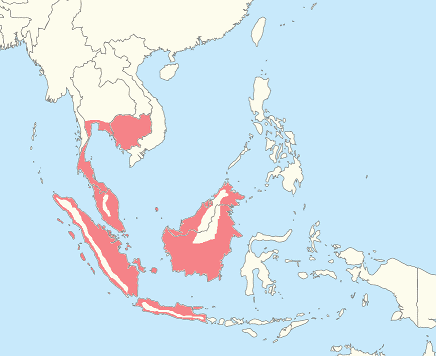
The blue coral snake has a large kingdom: Indonesia, Malaysia, Brunei, Singapore, Thailand and Burma. Unlike other snakes in the region, this snake has failed to make the leap to Australia, unless there’s a tiny undiscovered population somewhere. The furthest southeast they live is east Java in Indonesia. The northernmost extent of its range is Bangkok, itself in the middle south of Thailand.
There’s 3 subspecies of this snake. The “main” subspecies (c.b. tetrataenia) is actually only found on Borneo, while Calliophis bivirgatus bivirgata is found only on Java. The standard subspecies most commonly seen in internet images is c.b. flaviceps, which lives across the entire range except for Java.
The differences are subtle, and mostly found in their stripes. For example, c.b. tetrataenia only has cream coloured stripes on its flanks rather than electric blue ones. The common C.b. flaviceps is decorated with a blue-coloured stripe on each flank, while c.b. bivirgata has no coloured stripes on its flanks at all.
| 10 | Two close lookalikes |
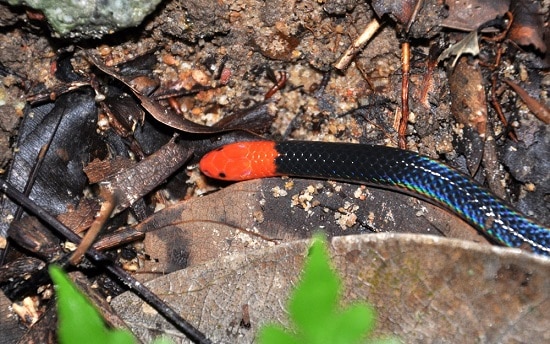
Not far away, there are two easily confused lookalikes known as the red-headed krait and the pink-headed reed snake. The former is venomous and dangerous while the latter has no venom, but the only way to tell the difference is by subtle scale and colour variations.
For example, the red-headed coral snake has a red head, but unlike the Malaysian blue, it has no red scales on its body. The same is true for the pink-headed reed snake (see picture above), and this species has a grey-white base of scales beneath the black ones. The red-headed krait also has an incredibly red tail, with a blotchy boundary as though an artist has dipped it in a bucket of red paint. The Malaysian blue coral snake has a red head and tail, but this time, a single thin line of the dark scales extends to the tip of the tail.
Neither of these lookalikes possesses any blue scales, but could easily be confused under dim, shadowy light. Be careful in the jungle!
